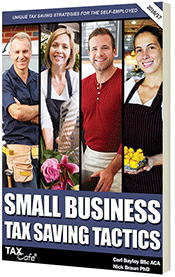Annual Investment Allowance
How to Claim a Cashback on Capital Expenditure
Many businesses are now approaching the end of their first accounting period under the new capital allowances regime introduced in April 2008.
Under the new regime, most businesses are entitled to immediate 100% relief for qualifying capital expenditure of up to £50,000 per year. This new relief is known as the annual investment allowance. Most spending on machinery, equipment and furniture for business use qualifies for the allowance, although cars do not usually qualify (but vans usually do).
Small Business Tax Guide
Furniture and equipment bought by landlords for use in residential dwellings is also excluded except in the case of qualifying furnished holiday accommodation.
For the first time in a generation, many businesses are therefore now in the position of obtaining immediate 100% tax relief for any qualifying capital expenditure incurred by their accounting date.
Let’s take Jamie, a self-employed plumber drawing up accounts to 31st March each year. Since 1st April 2008, Jamie has bought a few small tools but has not bought any significant capital items. His forecast profits for the year ending 31st March 2009 are £75,000, which will push him well into higher rate Income Tax.
Jamie is thinking of buying a new van for his business at a cost of £20,000. If Jamie buys the van by 31st March, he will be able to deduct the full cost of the van from his business profits, saving him £8,200 in Income Tax and National Insurance (at 40% and 1% respectively).
Jamie has a problem though. Having just paid his tax bill for the previous year on 31st January, he doesn’t have enough money left for the new van. “It’s a vicious circle,” he says to himself, “you pay your tax one year then can’t afford the money you need to spend to avoid another big bill next year!”
Two little letters provide the answer to Jamie’s problem: ‘HP’.
Jamie could buy his new van on hire purchase and, provided that he signs the purchase contract and brings the van into use in the business by 31st March, he will be entitled to 100% tax relief this year for the entire capital cost of £20,000. (Assets bought on hire purchase must actually be brought into use in the business by the accounting date in order to be eligible for capital allowances in the year of purchase.)
So, for a relatively small initial outlay, Jamie will achieve his full tax saving this year.
Furthermore, having reduced his taxable profits for 2008/9 by £20,000, Jamie may have grounds to apply to reduce his self-assessment payments on account due on 31st January and 31st July 2009. This will retrospectively reduce the tax he had to pay on 31st January 2009, as well as reducing the instalment due on 31st July.
If, like many people at the moment, Jamie’s current year profits are less than last year’s, he is likely to be able to claim an immediate tax repayment or, if you like, a ‘cashback’, of £4,100. That should sort out the HP payments on the van for a few months!
And, if Jamie has young children, his reduced business profits may entitle him to extra Tax Credits. In fact, taking the income disregard into account, Jamie may get extra Tax Credits next year as well, giving him total tax relief of up to 119% on his new van.
Deal or No Deal?
As we have seen, smaller businesses will generally benefit by buying capital items by their accounting date. For larger businesses, however, there may sometimes be a case for deferring capital spending. Once the business has spent enough to secure its maximum annual investment allowance, any further expenditure will attract writing down allowances at just 20%.
Example
Fraser Limited has a 31st March accounting date and is currently engaged in a programme to replace its older machinery at a total cost of £90,000.
If the company spends the entire £90,000 by 31st March 2009, it will be entitled to 100% relief on the first £50,000, but a writing down allowance of just 20% on the remaining £40,000 (i.e. £8,000). This would leave a balance of £32,000 to be carried forward to next year when it would again attract a writing down allowance of just 20% (i.e. £6,400).
Alternatively, however, by deferring £40,000 of its expenditure until after 31st March 2009, the company would be able to obtain immediate 100% relief on the entire £90,000: £50,000 this year and £40,000 next.
The main point here is that a business which has already spent enough to obtain the maximum annual investment allowance in its current accounting period, but which does not expect to spend enough to obtain the maximum allowance next year, will generally benefit by deferring any further qualifying capital expenditure until after its accounting date.
There’s a little quirk for sole traders and partnerships with a 31st March accounting date to watch out for here. Under transitional rules, their maximum annual investment allowance for the year ending 31st March 2009 is £49,315.






